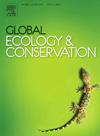Modern Abies, Picea, and Tsuga pollen distribution along the elevation gradient in East Asia
IF 3.5
2区 环境科学与生态学
Q1 BIODIVERSITY CONSERVATION
引用次数: 0
Abstract
Sub-alpine dark coniferous forests (SCFs) exhibit distinct latitudinal and longitudinal elevation distributions in East Asia. The SCF genera Abies, Picea, and Tsuga produce distinctive pollen and have specific elevation and climate requirements, allowing for the reconstruction of paleo-climatic and paleo-elevational changes from fossil pollen sequences. However, the relationship between SCF elevational distribution and the percentage of coniferous pollen has not been elucidated at the continental scale. In this study, we determined the relationship between Abies, Picea, and Tsuga pollen percentages and SCF elevation distributions in East Asia using an integrated pollen dataset comprising 4863 modern samples. The total percentage of these pollen types showed bimodal patterns with elevation and unimodal patterns with climate. Maximum pollen percentages occurred at elevations of 0–1000 and 2000–4600 m, mean annual temperatures of −5–10 ℃, and mean annual precipitation values of 100–1500 mm. The elevation with the highest proportion of Abies + Picea + Tsuga pollen increased with decreasing latitude: from 500 m (>43°N) to 2300 m (37–43°N), to 3500 m (30–37°N), and to 4000 m (18–30°N). Elevation also exhibited non-monotonic variations with longitude, first increasing from 2500 m (<93°E) to 3500 m (93–102°E), and then decreased to 2500 m (102–113°E) and 500 m (>113°E). The spatial patterns of Abies, Picea, and Tsuga pollen abundance were closely correlated with modern SCF distributions, which are largely modulated by climate and elevation. This study lays the foundation for reconstructing paleo-climate and paleo-elevation variations across East Asia.
东亚地区沿海拔梯度的现代松柏、云杉和铁杉花粉分布情况
亚高山黑针叶林(SCFs)在东亚表现出独特的纬度和纵向海拔分布。亚高山针叶林中的Abies、Picea和Tsuga属产生独特的花粉,并对海拔和气候有特定的要求,因此可以通过花粉化石序列重建古气候和古海拔的变化。然而,SCF海拔分布与针叶树花粉比例之间的关系尚未在大陆尺度上得到阐明。在本研究中,我们利用由4863个现代样本组成的综合花粉数据集,确定了东亚地区的Abies、Picea和Tsuga花粉比例与SCF海拔分布之间的关系。这些花粉类型的总百分比与海拔高度呈双峰模式,与气候呈单峰模式。在海拔 0-1000 米和 2000-4600 米、年平均气温为 -5-10 ℃、年平均降水量为 100-1500 毫米的地区,花粉比例最高。赤松+红松+铁杉花粉比例最高的海拔高度随着纬度的降低而增加:从 500 米(北纬 43°)到 2300 米(北纬 37-43°),再到 3500 米(北纬 30-37°)和 4000 米(北纬 18-30°)。海拔高度随经度的变化也呈现非单调变化,先从 2500 米(93°E)上升到 3500 米(93-102°E),然后下降到 2500 米(102-113°E)和 500 米(113°E)。Abies、Picea和Tsuga花粉丰度的空间模式与现代SCF的分布密切相关,而现代SCF的分布在很大程度上受气候和海拔的影响。这项研究为重建整个东亚地区的古气候和古海拔变化奠定了基础。
本文章由计算机程序翻译,如有差异,请以英文原文为准。
求助全文
约1分钟内获得全文
求助全文
来源期刊

Global Ecology and Conservation
Agricultural and Biological Sciences-Ecology, Evolution, Behavior and Systematics
CiteScore
8.10
自引率
5.00%
发文量
346
审稿时长
83 days
期刊介绍:
Global Ecology and Conservation is a peer-reviewed, open-access journal covering all sub-disciplines of ecological and conservation science: from theory to practice, from molecules to ecosystems, from regional to global. The fields covered include: organismal, population, community, and ecosystem ecology; physiological, evolutionary, and behavioral ecology; and conservation science.
 求助内容:
求助内容: 应助结果提醒方式:
应助结果提醒方式:


